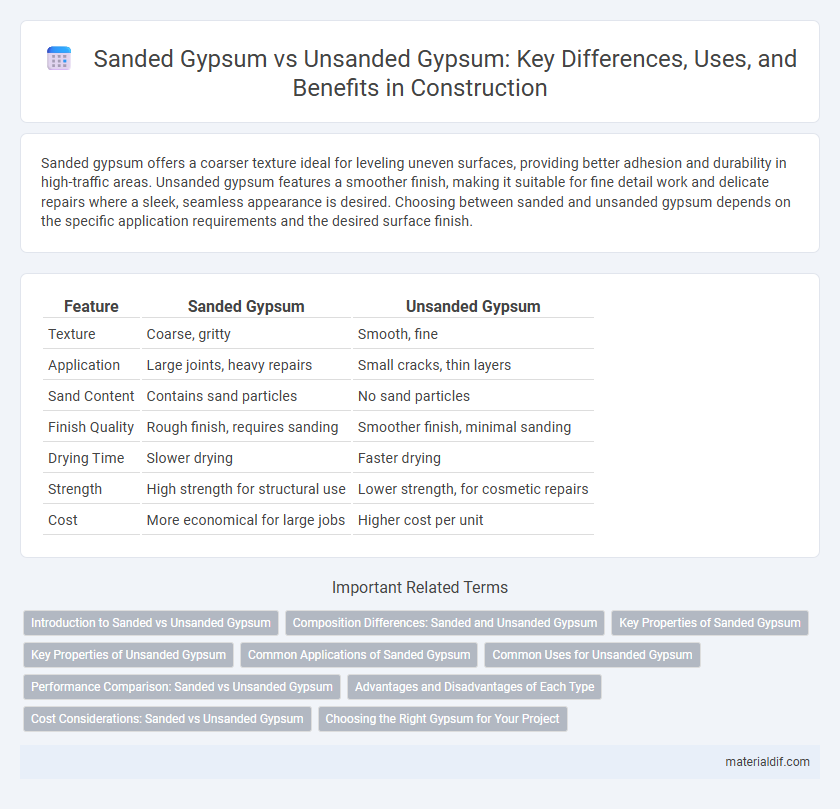Sanded gypsum offers a coarser texture ideal for leveling uneven surfaces, providing better adhesion and durability in high-traffic areas. Unsanded gypsum features a smoother finish, making it suitable for fine detail work and delicate repairs where a sleek, seamless appearance is desired. Choosing between sanded and unsanded gypsum depends on the specific application requirements and the desired surface finish.
Table of Comparison
| Feature | Sanded Gypsum | Unsanded Gypsum |
|---|---|---|
| Texture | Coarse, gritty | Smooth, fine |
| Application | Large joints, heavy repairs | Small cracks, thin layers |
| Sand Content | Contains sand particles | No sand particles |
| Finish Quality | Rough finish, requires sanding | Smoother finish, minimal sanding |
| Drying Time | Slower drying | Faster drying |
| Strength | High strength for structural use | Lower strength, for cosmetic repairs |
| Cost | More economical for large jobs | Higher cost per unit |
Introduction to Sanded vs Unsanded Gypsum
Sanded gypsum contains fine sand particles mixed into the gypsum, enhancing its durability and making it ideal for filling larger gaps and repairing rough surfaces. Unsanded gypsum is smoother and finer, suitable for delicate finishing and filling small cracks before painting or wallpapering. Choosing between sanded and unsanded gypsum depends on the surface texture and the size of the repair area.
Composition Differences: Sanded and Unsanded Gypsum
Sanded gypsum incorporates fine sand particles within its composition, enhancing its texture and providing greater strength and durability for applications like patching larger holes or repairing uneven surfaces. Unsanded gypsum lacks these sand additives, resulting in a smoother finish ideal for minor repairs, thin layers, and delicate surfaces that require a fine, polished appearance. The compositional difference primarily impacts workability and finishing properties, with sanded gypsum offering more grip and structural integrity while unsanded gypsum facilitates easier sanding and finer detailing.
Key Properties of Sanded Gypsum
Sanded gypsum features coarse sand particles that enhance its durability and resistance to cracking, making it ideal for filling large gaps and exterior applications. Its texture provides superior adhesion and a stronger bond compared to unsanded gypsum, which is smoother and better suited for fine detailing or small repairs. High compressive strength and water resistance are key properties that set sanded gypsum apart in construction and finishing tasks.
Key Properties of Unsanded Gypsum
Unsanded gypsum is characterized by its fine, smooth texture, making it ideal for detailed finishing and delicate surface repairs where a high-quality finish is required. Its low coarseness and enhanced bonding properties allow it to adhere better to surfaces without cracking or shrinking during drying. This type of gypsum also sets rapidly, providing a durable and hard finish suitable for interior applications like drywall joint treatment and intricate molding work.
Common Applications of Sanded Gypsum
Sanded gypsum is commonly used in floor joint filling, patching concrete surfaces, and repairing large cracks due to its superior durability and resistance to shrinkage. It provides a strong, stable base that supports structural integrity in flooring and masonry applications. This type of gypsum is ideal for high-traffic areas and exterior surfaces where extra strength is required.
Common Uses for Unsanded Gypsum
Unsanded gypsum is primarily used for filling small cracks, nail holes, and minor surface imperfections due to its smooth texture and fine consistency. This type enables easy application and sanding, making it ideal for interior wall repairs and finishing touches before painting. Its fine grain ensures a seamless finish on delicate surfaces without the roughness associated with sanded gypsum.
Performance Comparison: Sanded vs Unsanded Gypsum
Sanded gypsum offers superior durability and better resistance to cracking due to its coarse aggregate composition, making it ideal for high-traffic or exterior applications, while unsanded gypsum provides a smoother finish with less shrinkage, suitable for interior, fine-detail work. The performance of sanded gypsum excels in areas requiring impact resistance and adhesion, whereas unsanded gypsum is preferred for its ease of application and minimal surface texture. Choosing between sanded and unsanded gypsum depends on balancing the need for strength versus finish quality in construction and decorative projects.
Advantages and Disadvantages of Each Type
Sanded gypsum offers superior strength and reduced shrinkage, making it ideal for filling larger gaps and cracks with increased durability, but it may be more difficult to sand smooth afterwards. Unsanded gypsum provides a smoother finish and is easier to sand, which is preferred for fine detail work and small repairs, though it tends to shrink more and may crack if applied thickly. Choosing between sanded and unsanded gypsum depends on the specific project requirements such as surface texture, crack size, and finishing needs.
Cost Considerations: Sanded vs Unsanded Gypsum
Sanded gypsum is generally more cost-effective for larger projects due to its sand content, which reduces the overall price per volume compared to unsanded gypsum. Unsanded gypsum, while typically more expensive, offers a smoother finish ideal for smaller, detailed work where precision justifies the higher cost. Budget planning should weigh the balance between material expense and the desired surface texture to optimize project costs effectively.
Choosing the Right Gypsum for Your Project
Sanded gypsum provides a textured finish ideal for high-traffic areas and surfaces requiring durability, while unsanded gypsum offers a smooth finish suitable for delicate applications such as fine detail work and interior walls. Selecting the right gypsum depends on the project's surface type, desired finish, and exposure to wear, with sanded gypsum favored for floors and exterior walls and unsanded gypsum preferred for ceilings and decorative trim. Proper material choice ensures longevity and aesthetic quality, minimizing cracks and imperfections over time.
Sanded gypsum vs Unsanded gypsum Infographic

 materialdif.com
materialdif.com